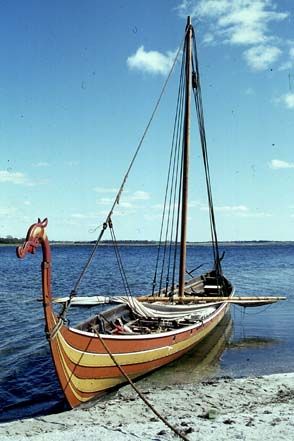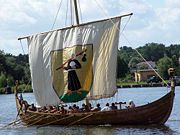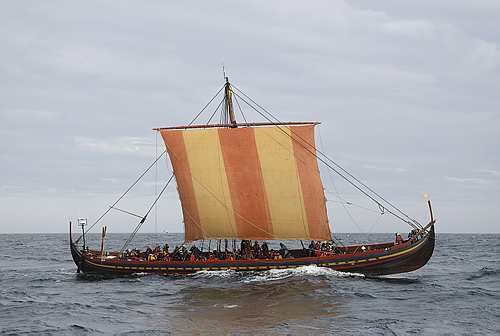Viking Ships: The Drakkar
Size
The average length of a longship was 28 meters. The largest ever excavated was seventy meters long. Its sixty oarsmen could swiftly deliver as many
as four hundred warriors to a battlefield along the coast or
well inland via a river. Like most large drakkars, it was owned
by a powerful king. He was the only one who could afford to
build it. In the last days of the Viking Age, three hundred of
these longships were in the Viking fleet.
deliver as many
as four hundred warriors to a battlefield along the coast or
well inland via a river. Like most large drakkars, it was owned
by a powerful king. He was the only one who could afford to
build it. In the last days of the Viking Age, three hundred of
these longships were in the Viking fleet.
Crew
The average longship owned by an earl or nobleman carried a crew of twenty to thirty oarsmen. They rowed the ship when the winds were slight or calm. Other crew members included a helmsmen, who steered the ship; a lookout who watched for rocks in shallow waters and a few spare men who took the place a tired oarsmen or replaced one lost overboard during a storm. The remaining men onboard were warriors, eager to do battle or to raid a community and rob it of its riches.The Vikings named their longships according to the number of pairs of oars they carried and the purpose the ship served. The tjue-sesser, for example, had twenty pairs of oars. They were probably owned by a settlement and used to serve the king when he needed their help. The most common drakkar though, had thirty rowers and were the pride of Viking earls and kings. These were the best built in the Viking fleet. These appeared only in the biggest wars during the last years of the Viking Age.
Construction
Like all Viking ships, the longship was constructed using the clinker design. This means it was planked using two centimeter thick oak boards which were overlapped slightly and then nailed together with iron nails. The spaces between the planks were caulked with tarred wool or animal fur to make the ship watertight. The planks were also nailed to support-ribbing that ran from the gunwale to the keel. The keel, which ran the full length of the ship, was made of one solid piece of oak. It added stability and made the ship travel straight through the water.The longship was very sturdy, and yet flexible enough to withstand the waves of stormy seas and light enough to be dragged overland between two lakes or rivers. The prow, or bow, was sometimes tipped with a very ornate carving of a snake or dragon head, thus earning it the nickname "dragon ship". The prow ornament was removed while the ship was at sea. Replacing such a finely carved piece would be expensive and losing it might be a bad omen.
Sail and Mast
The sail of a Viking ship was very expensive to make, often costing more than the rest of the ship itself.
Sail design is often misrepresented in modern drawings and
replicas. Tapestries from the Viking age show a cross-hatched
pattern in the sail, a result of how it was made.
the rest of the ship itself.
Sail design is often misrepresented in modern drawings and
replicas. Tapestries from the Viking age show a cross-hatched
pattern in the sail, a result of how it was made.The sails of all Viking sailing ships, were made of wool from sheep or linen from the flax plant. Making them was the responsibility of Viking women. First, small diamond-shaped pieces were woven and then trimmed with leather. The leather helped the wool or linen pieces to keep their shape, especially when wet. All of these diamond pieces were then carefully sewn together to make one large square sail, the leather strips giving them the cross-hatched pattern. The sails of Viking ships were usually as wide as half the ship's length.
Red dye was added to the leather trim to give the sail the vivid cross-hatched pattern. Sometimes the whole sail was dyed a solid red colour. The choice of red, the colour of blood, was meant to strike fear into the hearts of the Vikings' enemies. The sail was hoisted and held in place on the center mast with ropes likely made from walrus hide. Once it caught a steady breeze, the sail could move the ship a very swift twelve knots. If the winds were calm, twenty to thirty oarsmen could move the ship briskly through the water at about five knots.
At night, the sail was lowered and removed from the ship. In bad weather, it often served as a tent. The Vikings, inventors of the sleeping bag, would sleep under the sail for protection.
The mast that held the sail was attached directly to the sturdy keel. The mast could be removed and laid on the deck. This was done in high winds and heavy seas so it would not break. Replacing a broken mast would not be possible on a raid.
At Sea
Viking ships were rarely at the mercy of their enemies. Their ships were better than any others sailing in Europe at that time. They could navigate in water less than 3 feet deep. In shallow water, the warriors would move to one side of the ship to tilt it so it would pass over rocks and shoals. The longships' tapered bows and sterns enabled the Vikings to row the ship forwards and backwards without first having to turn it around. This was a great advantage when fleeing after a raid.Drakkars are often pictured with shields hanging from the gunwales. These shields were held in place by racks or ropes. The shields protected the warriors against arrows and spears during sea battles. They also protected raiding parties as the ships neared shore. It is a myth that the shields were always in these racks while at sea. In rough seas, shields could easily be lost overboard. Warriors, depending on their shields for their lives, would likely have stored them safely on board the ship.
The deck of a longship was completely planked over. There were no sleeping quarters below deck. Crewmen and warriors stored their personal belongings in chests on the deck. The oarsmen sat on these chests when rowing.
Meals on a drakkar weren't great. Cooking on an open fire was not practical on a wooden ship in choppy seas. Food consisted of dried meat, freshly caught fish, sour milk, water, beer, nuts and cloudberries. Spoiling was often a problem.
The Berserker
The Vikings eventually settled down in many of the countries they had invaded. Consequently, some of their words entered the language spoken by the locals. One Viking word that entered our language was berserk. It was used to name a type of Viking fighter. When a Viking longship neared a coastline, ten to fifteen warriors often dressed in bear skins would move to the front of the ship and work themselves into a frenzy. Sometimes this was done by shouting battle whoops, sometimes it was done with the aid of hallucinogenic mushrooms. As the longship neared a beach, these warriors, called "berserkers," would go over the side shouting and waving their swords in anticipation of a battle. This too created fear in their enemies. Some berserkers were so worked up, they jumped too soon and drowned in water over their heads. In our language, going "berserk" is taken from these fierce Viking warriors.With their blood red sails, snarling prowed ships and hundreds of sword-wielding warriors, the Vikings created a sight that brought terror into the hearts of people across Europe, North Africa and a small area of western Asia until the end of the Viking Age.
The importance of the longboat to the Vikings cannot be underestimated. It was a symbol of both wealth and power and was closely associated with the owner's personality. In fact, the boats were so important to the Norse that many warriors were actually buried in them to be used in the afterlife. Many fine examples of longboats used for burial have been found over the past several decades.
By the Nineteenth Century the longboat was obsolete, replaced by larger, faster ships capable of carrying larger payloads farther with fewer crew. However, the longboat continued to sail the icy waters of Northern Europe, but without causing the fear the longboat brought in the previous centuries as it sailed along the coast or up a river looking for a target of opportunity.
The Viking longboat had a tremendous influence on Europe, economically and socially, even contributing to a large degree to the establishment of Feudalism. But that is a topic for another article.

Editor's Note: Many thanks to Thomas Long, Jr. and Jim Cornish who contributed heavily to this article.